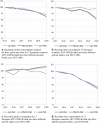Alcohol consumption and closed borders - how COVID-19 restrictions have impacted alcohol sales and consumption in Europe
- PMID: 35395783
- PMCID: PMC8993209
- DOI: 10.1186/s12889-022-13014-1
Alcohol consumption and closed borders - how COVID-19 restrictions have impacted alcohol sales and consumption in Europe
Abstract
Background: The closing of bars, restaurants and international borders during the COVID-19 pandemic led to significant changes in alcohol availability. This study provides a first systematic overview of the monthly development of alcohol sales in Europe during the pandemic in order to determine the effect of closed borders on the sales and consumption of alcohol.
Methods: The study covers 72 months from January 2015 to December 2020 in 14 countries from northern, central and western Europe with excise revenue data for beer, spirits, wine separately and summed, converted into litres of pure alcohol per capita 15+ as a proxy for alcohol sales. March-December 2020 is seen as the pandemic period. The analyses consist of (1) descriptive trends of sales before and during the pandemic, (2) assessment of the pandemic impact on sales by time-series analyses and (3) case studies of countries and a region with substantial cross-border inflow or outflow of alcohol.
Results: The result shows an overall reduction in alcohol sales with 3.6% during the pandemic. Nevertheless, the results differ based on the level of cross-border purchasing flows pre-pandemic, as countries with high cross-border inflow saw an increase in domestic sales as the pandemic hit. Norway, for example, saw a 23% increase in domestic sales during the pandemic period March-December 2020 compared to the same period in 2019.
Conclusion: The closing of intra-European borders had a significant redistributing effect on alcohol sales. While noting sales increases, cross-border inflow countries generally saw a decrease in total amount of alcohol consumed per capita as not all cross-border purchases were replaced by domestic sales. This has important policy implications as large volumes of cross-border inflow of alcohol can negatively affect excise revenue as well as public health outcomes. The methodology can be used to further explore the reliance of different purchasing streams in a domestic alcohol market.
Keywords: Alcohol consumption; Alcohol sales; COVID-19 pandemic; Crisis-response impact; Cross-border alcohol trade; Substitution.
© 2022. The Author(s).
Conflict of interest statement
Emil Juslin is, and Kalle Dramstad was, employed as a political secretary at IOGT-NTO, a voluntary organization within the Swedish temperance movement that works with alcohol policy issues by promoting science-based policies independent of commercial interests, as well as with drug policy and preventive and social work, both internationally and in Sweden.
Håkan Leifman declares no conflict of interest.
Figures




Similar articles
-
Changes in the dollar value of per capita alcohol, essential, and non-essential retail sales in Canada during COVID-19.BMC Public Health. 2021 Nov 25;21(1):2162. doi: 10.1186/s12889-021-12226-1. BMC Public Health. 2021. PMID: 34823488 Free PMC article.
-
The concerning increasing trend of alcohol beverage sales in the U.S. during the COVID-19 pandemic.Alcohol. 2021 Nov;96:37-42. doi: 10.1016/j.alcohol.2021.06.004. Epub 2021 Jul 8. Alcohol. 2021. PMID: 34245809 Free PMC article.
-
When the pubs closed: beer consumption before and after the first and second waves of COVID-19 in Australia.Addiction. 2021 Jul;116(7):1709-1715. doi: 10.1111/add.15352. Epub 2021 Jan 3. Addiction. 2021. PMID: 33245567 Free PMC article.
-
Prohibiting alcohol sales during the coronavirus disease 2019 pandemic has positive effects on health services in South Africa.Afr J Prim Health Care Fam Med. 2020 Jul 15;12(1):e1-e4. doi: 10.4102/phcfm.v12i1.2528. Afr J Prim Health Care Fam Med. 2020. PMID: 32787395 Free PMC article. Review.
-
Alcohol Consumption and the Physical Availability of Take-Away Alcohol: Systematic Reviews and Meta-Analyses of the Days and Hours of Sale and Outlet Density.J Stud Alcohol Drugs. 2018 Jan;79(1):58-67. J Stud Alcohol Drugs. 2018. PMID: 29227232 Review.
Cited by
-
Alcohol use and COVID-19: three-year impact for the Czech Republic.Cent Eur J Public Health. 2025 Jun;33(2):122-131. doi: 10.21101/cejph.a8410. Cent Eur J Public Health. 2025. PMID: 40625137
-
Changes in self-reported alcohol consumption in relation to financial and mental health problems: Experiences from the COVID-19 pandemic in Sweden.Nordisk Alkohol Nark. 2025 Jun;42(3):243-256. doi: 10.1177/14550725251328161. Epub 2025 Mar 25. Nordisk Alkohol Nark. 2025. PMID: 40160232 Free PMC article.
-
Changes in Alcohol-Specific Mortality During the COVID-19 Pandemic in 14 European Countries.Sucht. 2023 Dec;69(6):285-293. doi: 10.1024/0939-5911/a000841. Epub 2023 Dec 5. Sucht. 2023. PMID: 39183774 Free PMC article.
-
Assessing the early influence of COVID-19 in an analysis of the immediate implementation of Minimum Pricing for Alcohol on drinkers in Wales.Nordisk Alkohol Nark. 2024 Feb;41(1):57-74. doi: 10.1177/14550725231202066. Epub 2023 Oct 3. Nordisk Alkohol Nark. 2024. PMID: 38356791 Free PMC article.
-
The impact of the COVID-19 pandemic on mortality in Sweden-Did it differ across socioeconomic groups?Eur J Epidemiol. 2024 Feb;39(2):137-145. doi: 10.1007/s10654-023-01068-3. Epub 2024 Jan 5. Eur J Epidemiol. 2024. PMID: 38177570 Free PMC article.
References
-
- The World Tourism Organization (UNWTO) The UNWTO Tourism Recovery Tracker. 2021.
-
- Babor FT, et al. Alcohol: no ordinary commodity: research and public policy. 2. Oxford University Press; 2010.
Publication types
MeSH terms
LinkOut - more resources
Full Text Sources
Medical

